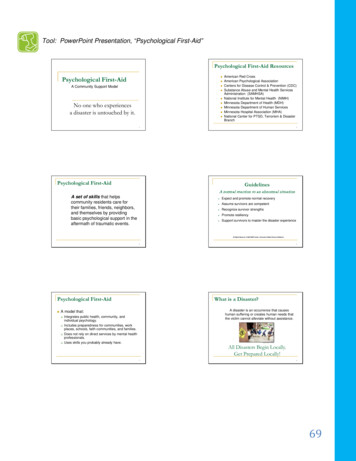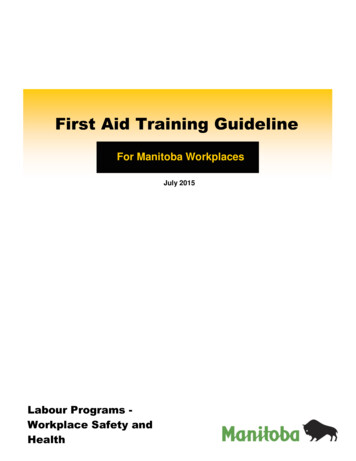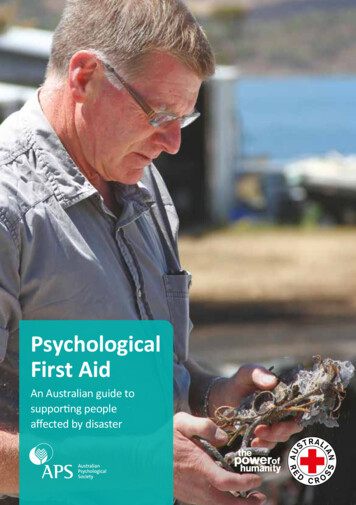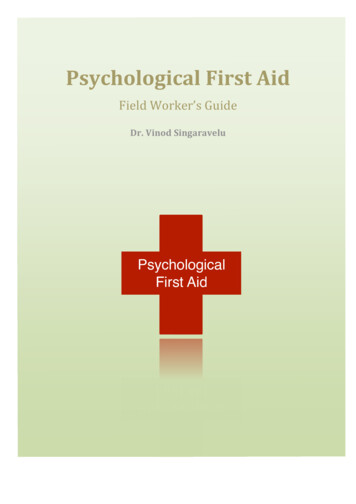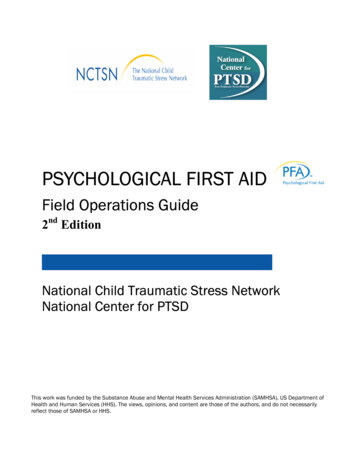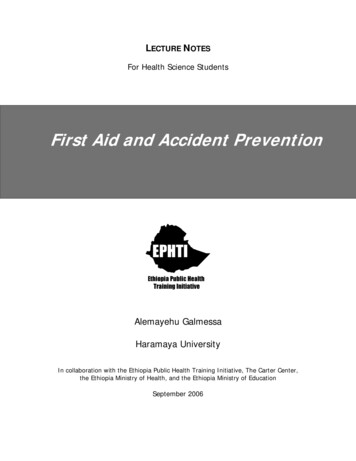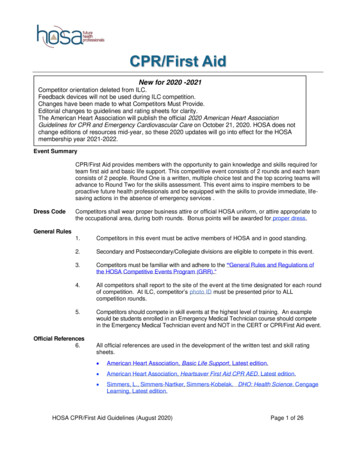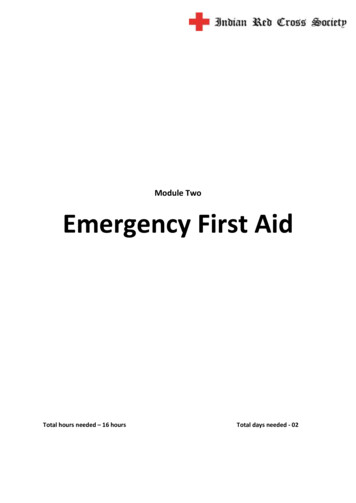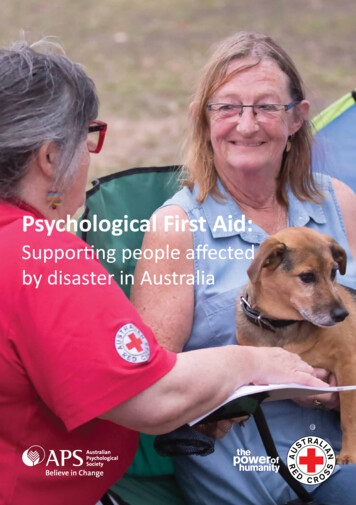
Transcription
Psychological First Aid:Supporting people affectedby disaster in Australia
Psychological First Aid:Supporting people affectedby disaster in Australia Australian Red CrossThird edition published by:Australian Red Cross 2020155 Pelham St, Carlton, Victoria 3053andAustralian Psychological SocietyLevel 11, 257 Collins St, Melbourne, Victoria 3000Photography copyright: All images are referencedwithin and remain the property of the AustralianRed Cross, stated photographer, or other parties asnoted.Within this resource, the term ‘emergency’ is usedand can apply to any form of emergency incidentor disaster. Where the term ‘disaster’ is used, this isinterchangeable to ‘emergency’ and connotations ofone term over the other should not be made.All rights reserved. No part of this publication maybe reproduced, stored in a retrieval system, ortransmitted in any form, or by any means, electronic,mechanical, photocopying, recording or otherwisewithout the prior written consent of the publisher.Cover image: Australian Red Cross
ContentsForeword4Psychosocial reactions to crisis situations8Psychological first aid for children30Additional guidance for supporting children3234Common reactions10Complex reactions12Psychological first aid for people with physical ormental health conditions or intellectual disabilitiesUnderstanding psychological first aid14Self care for people working in the field38What is psychological first aid?15Reducing stress39What psychological first aid isn’t16Look, Listen, Link for self care40The aim of psychological first aid17Supporting your colleagues41Five elements of psychosocial support18Useful organisations42Providing psychological first aid22Who benefits from psychological first aid?23References and resources44Who delivers psychological first aid?24Acknowledgments48Where is psychological first aid given?25When do you provide psychological first aid?25End Notes50Psychological first aid action principles26Fundamental Principles52Preparing to provide psychological first aid in the field2823
ForewordThis psychological first aid guide isfor people working in disasterpreparedness, response and recovery.It provides an overview of bestpractice approaches to psychologicalfirst aid following disasters andtraumatic events.In Australia, each state and territoryhas plans to deal with the healthimpacts of disasters. Included in theseplans are arrangements that cover themental health impacts of emergencies.4This guide sets out to simply outlinehow psychological first aid can beoperationalised in Australia. The guide isalso used in conjunction with psychologicalfirst aid training delivered by AustralianRed Cross.Emergency is the generic term used inAustralia to describe disruptive and/or destructive events that cause loss oflife, property and livelihoods, injury anddamage to communities. For the individualthis may mean the loss of: Loved ones or significant othersControl over one’s own life and futureHope and initiativeDignitySocial infrastructure and institutionsAccess to servicesProperty and belongingsLivelihoodsThe natural environment, importantcultural sites and other places ofsignificance.After an emergency, people can loseconfidence in the norms, networks, andtrust in the society that is supposed toprotect them.1 Until the late 1970s, thepsychosocial aspect of emergencies wasoften ignored. Emergency managementactivities focused more on the rebuildingof towns damaged by floods, fire orstorms and healing the physical wounds ofthose injured.Disaster mental health and theidentification of post-traumatic stressdisorder led to a shift in approaches toemergency management. Responses duringthis period focused on applying clinicalmental health skills in emergency settings,for which they were never intended.It has been recognised both in Australiaand internationally that psychosocialsupport in emergencies is best deliveredas a community-based activity.1 Providingcoordinated psychosocial support inemergencies has now become a criticalpart of preparing for, responding to andrecovering from an emergency.This guide is in line with thefollowing resources:A Guide to Psychological First Aid(International Federation of Red CrossRed Crescent Societies, 2018) andPsychological first aid: Guide for fieldworkers (World Health Organization, WarTrauma Foundation and World VisionInternational, 2011).It was then recognised that most peopledid not develop serious mental healthissues after emergencies. Most peoplerecover well with some basic support. Thisled to the development of psychologicalfirst aid as a primary tool for supportingpeople after an emergency.5
6Australian Red Cross7
Psychosocialreactions tocrisis situationsPeople may experience strongemotional and physical distressreactions when faced with situationsthat result in death, or serious injuryto themselves or others. Feelings ofintense fear and thinking one maydie or be seriously injured can alsocause intense feelings of distress.These situations can be either directlyexperienced or witnessed. The lossof treasured belongings, communityicons and connections to place also cancause psychosocial distress.There are many different situationsthat may cause people to experiencesuffering and distress.8These may include situations such as: Personal crisesSocial challengesHealth challengesDisasters caused by natural hazardsHuman caused disastersViolenceArmed conflictForced migration.2Community-level crisis situations, suchas disasters, armed conflict and forcedmigration have far-reaching and variedimpacts on people and the communitiesthey belong to, geographic or otherwise.The impacts of disasters affect all aspectsof wellbeing, degrade quality of lifeand undermine the social connectivityof communities.39
How people react to difficult experiencesdepends on the nature of the experience,their resilience, their age and personality,their support system and usual copingmethods, how much time has passedsince the time of the event, and previousexperiences.However, there are some commonemotional and physical distress reactionsthat can be expected immediately duringand in the days, weeks, months or yearsafter a crisis event.4 These include, but arenot limited to: Feelings of guilt, sadness, relief, anger,fear, anxiety, confusion, uncertainty,hopelessness Feeling numb, increased heartbeat,sweating, shaking, trembling orshortness of breath Difficulty making decisions andcomprehending complex information Difficulty communicating clearly withothers Feelings of helplessness orpowerlessness Feeling overwhelmed.10Remember:5 People do not all react at the same timeor in the same way to a crisis Not everyone needs or wants support Witnesses to a frightening event mayalso be strongly affected and needsupport Some people are calm and do not reactstrongly at the time of an event, buthave strong reactions later Some people have strong reactions, andcan manage their situation on their own,or have support from other sources.Australian Red CrossCommon reactionsStressStress is a state of pressure or strain thattakes place in many different situations.It can be caused by any change – positiveor negative. Stress is an ordinary part ofeveryday life. It is positive when it makesa person perform well, for example, in atest or exam. However, stress can also benegative and lead to distress and crisis.6DistressThis is when someone is unable to copewith or adapt to the challenges or situationthey are facing. Distress leads to physicaland emotional discomfort and suffering. Itcan be caused by a one-off crisis event orfrom stress building up over time.711
Complex reactions8Complex reactions are more serious thancommon reactions to distress. A personwith complex reactions often needs referralfor specialised help or other assistance.Examples of complex reactions are:Panic attacks and feelings ofoverwhelming anxiety can produce a fasterheartbeat, shortness of breath, and pain inthe chest. A person may sweat more thannormal, feel dizzy or light-headed and feellike they want to be sick.Anger and aggressive behaviour arefamiliar reactions to crisis in situations ofviolence, or when people have experiencedimmense losses.Self-harm and suicide. Self-harm is when aperson hurts himself or herself on purpose,for example, by cutting or burning theirskin and flesh. Suicide is when someoneintentionally takes his or her own life.It is important to always take someonewho threatens to harm or kill themselvesseriously and not leave the person aloneuntil more help arrives.Harmful coping methods include selfmedicating with drugs or alcohol, becomingviolent or aggressive, withdrawing orkeeping oneself completely apart fromother people.12Prolonged grief is when someone findsit hard to accept and adapt to the loss ofsomeone they loved. The grief then affectshow the person lives from day to day andhow they relate to other people. It is notan immediate reaction. It develops over aperiod of time. It can also lead to extremefeelings of distress when the personexperiences new challenges or is somehowreminded of their grief.Sleeping problems are very common aftercrises. Many people find it difficult to fallasleep or experience nightmares. Somepeople sleep more than usual and find ithard to wake up. If sleeping problems goon for many days and nights, it can leadto physical and psychological problems.Severe sleeping problems interfere withdaily living, moods and relationships withother people, and seeking support canbe helpful.Certain factors can increase the risk ofdeveloping complex reactions. For exampleif the person: Was separated from their family Thought they were going to die Was involved in a situation where thehorror element was high Has had previous traumatic experiences Lost loved ones Has an underlying psychologicaldisorder.Feelings of anxiety and anger are commonreactions to crisis. However, some peoplemay experience intense or prolongedfeelings that do not resolve as expected.These people may benefit from morespecialised support.Flashbacks are when a person feels as ifthey are back in the moment of the originalstressful event. Flashbacks often feel realand can be confusing and frightening. Theycan be a normal reaction to abnormalexperiences. However, the person may stillneed help to manage them.13
Understandingpsychologicalfirst aidWhat is psychological first aid?Psychological first aid is a psychosocialsupport activity that helps peopleaffected by an emergency, disasteror traumatic event. It is a ‘humane,supportive response to a fellow humanbeing who is suffering and who mayneed support’.9It includes basic principles of psychosocialsupport to promote natural recovery.This involves helping people feel safe,connected to others, calm and hopeful,and ensuring access to physical, emotionaland social support.10 Psychological firstaid aims to reduce initial distress, meetcurrent needs, promote flexible coping andencourage adjustment.Psychological first aid is useful as the firstthing that you might do with individualsor families following a disaster. It is mostwidely used in the first hours, days andweeks following an event. However, therecan be situations months or years after anevent that trigger strong stress reactions,such as anniversaries of the event orexperiencing or witnessing somethingsimilar which reminds someone of the14stressful experience.11 Psychological firstaid can be a useful support activity at thesetimes as well, many of which may takeplace years after the event.Psychological first aid is based on anunderstanding that people affected bydisasters will experience a range of earlyreactions (physical, psychological, emotionaland behavioural). These reactions mayinterfere with their ability to cope.12 Thesereactions are normal and understandablegiven people’s experiences. Recovery maybe helped by psychological first aid.A small part of an affected populationwill have more complex reactions and willrequire further mental health support toassist recovery. But most people recoverwell on their own or with the support ofcompassionate and caring disaster workers,family and friends.Psychological first aid has a long history.13It has become more popular sincethe emergence of research showingthe dangers of critical incident stressdebriefing.14 Since 2002, psychological firstaid has been recommended as a key partof the provision of psychosocial supportfollowing disasters.15
Australian Red CrossThe aim of psychologicalfirst aidWhat psychological first aid isn’tIt is important to clarify what psychologicalfirst aid is not to differentiate it fromearlier forms of post-disaster support, mostnotably critical-incident stress debriefing.It is not useful – and may be harmful – todirectly encourage disaster survivors to talkabout what happened to them if they donot want to. If a person wants to discusstheir experiences, it is useful to providethem with support. But this should only bein a way that does not push them to discussmore than they want.15Post-emergency settings are not clinicalenvironments and it is inappropriateto conduct a clinical or psychologicalassessment within the setting.16It is important to limit contact at this pointto simple support, like psychological firstaid. People who display marked signsof risk (e.g. suicidal ideation) should bereferred to formal mental health services.Psychological first aid is: NOT debriefing NOT obtaining details of traumaticexperiences and losses NOT treating NOT labelling or diagnosing NOT counselling NOT something that only professionalscan do NOT something that everybody whohas been affected by an emergencywill need.Psychological first aid is fundamentallyabout providing humane andcompassionate care. It addresses emotionaland practical needs and concerns above allelse.An important aim of psychological first aidis to build people’s capacity to recover.Psychological first aid supports recovery byhelping people to identify their immediateneeds and their strengths and abilities tomeet these needs.One of the most important researchfindings is that a person’s belief in theirability to cope can predict their outcome.Typically people who do better aftertrauma are those who are optimistic,positive and feel confident that life andself are predictable, or who display otherhopeful beliefs.16 Facilitate people’s social support Help people understand the disaster andits context Help people identify their own strengthsand abilities to cope Foster belief in people’s ability to cope Give hope Assist with early screening for peopleneeding further or specialised help Promote adaptive functioning Get people through the first period ofhigh intensity and uncertainty Set people up to be able to recovernaturally from an event Reduce the risk factors of mental illnesssuch as posttraumatic stress disorder asa result of the event.The goals of psychological first aid includeefforts to: Calm peopleReduce distressMake people feel safe and secureIdentify and assist with current needsEstablish human connection17
There are five basic elements topsychosocial support that have been drawnfrom research on risk and resilience, fieldexperience and expert agreement.17 Theseelements underpin the psychologicalfirst aid approach. When providingpsychological first aid people should keepthese principles in mind.The elements of psychosocial support are: Ensuring safetyPromoting calmPromoting connectednessPromoting self-efficacy and groupefficacy Instilling hope.1. Ensuring safetyPeople’s experience of negativepsychological reactions following disastersor mass violence will continue while theyare under threat, in danger or perceive athreat to themselves or loved ones. Studieshave shown this to be the case acrosscultures. When safety is reintroducednegative reactions have been shown togradually reduce over time. Ensuring safetymay include: Removing people from, or reducing theirexposure to, the threat of harm Helping people meet basic needs forfood, water, shelter, financial and materialassistance Helping people obtain emergencymedical attention Providing physical and emotionalcomfort Providing repeated, simple andaccurate information, through a rangeof methods, on how to get these basicneeds met.2. Promoting calmSome anxiety, distress and negativepsychological reactions are normaland are healthy responses following atraumatic event. Most people will returnto manageable levels of emotions within18Australian Red CrossFive elements ofpsychosocial support19
days or weeks. However, ongoing negativesymptoms may lead to the developmentof longer term mental health disorders. Itis important to normalise stress reactions.Other ways of promoting calm may include: Stabilising people who are overwhelmedor disoriented Providing an environment, as far aspractical, removed from stressfulsituations or exposure to sights, soundsand smells of the emergency Listening to people who wish to sharetheir stories and emotions, withoutforcing them to talk Remembering that there is no right orwrong way to feel Being friendly and compassionate evenduring difficult interactions with people Offering accurate information about thedisaster or trauma and the relief effortsunderway to help survivors understandthe situation Providing information on stress andcoping Reminding people when they expressfear or worry, that more help andservices are on the way (if you know).203. Promoting connectednessFollowing crises, having access to socialsupport activities and networks increasesopportunities for emotional understanding,knowledge to be shared, to normalisereactions, and solve problems. Researchacross cultures has found that socialsupport is related to better emotionalwellbeing and recovery following masstrauma. Re-establishing connections withloved ones and fostering social connectionsas quickly as possible in the aftermathof crisis is critical to recovery. Promotingconnectedness may include: Helping people contact friends andloved ones Keeping families together Keeping children with parents or carers Helping establish contacts with supportpeople (friends, family or community) Offering practical help to people toaddress immediate needs and concerns Providing information and directingpeople to those services that areavailable Linking people with available services Respecting cultural norms regardinggender, age, family structures andreligion.4. Promoting self-efficacyHaving a sense of control over positiveoutcomes in one’s life is generallypsychologically beneficial. Following crisespeople may feel as though they lack thecompetency to handle tasks ahead. Mostsurvivors of disasters and mass violencehad the capacity to cope with and manageday-to-day problems prior to the crisis.In the aftermath, it is not so much aboutbuilding self-efficacy but reminding peopleof their efficacy. Promoting self-efficacymay include:Self-efficacy is the belief that one’s actionsare likely to lead to positive outcomes,and feeling able to help oneself. Engaging people in meeting their ownneeds Assisting with decision making, andhelping them to prioritise problems andsolve them.5. Instilling hopeThose who remain optimistic in timesof crisis are more likely to experiencefavourable outcomes following trauma.This is because people can retain areasonable degree of hope for their future.Instilling hope may include: Conveying an expectancy that peoplewill recover Being there/being willing to help Reassuring people that their feelingsare normal.21
Providingpsychologicalfirst aidWho benefits from psychologicalfirst aid?The sudden, disruptive nature ofemergencies means that people willbe exposed to uncertainty and stress.People will experience differentdegrees of distress. Any personin distress should have access topsychological first aid, where possible.This includes adults, adolescents andchildren, as well as disaster relief andrecovery workers and first responders.How people respond and cope dependson a variety of factors, including theirexperience of the emergency, their health,their personal history and their availablesupports.Some people may have more complexreactions and may be more at risk ofnegative consequences than others. Thesemay include those people who: Have had previous traumaticexperiences Have underlying mental illnesses22 Were exposed to events where thehorror element was high Thought they were going to die Have experienced traumaticbereavement Have had serious losses of property,livelihoods, or disruption tocommunities and networks.There will also be some complex situationswhere people have an immediate needfor more care than can be provided bypsychological first aid. These people needto be promptly referred to specialisedsupport. This includes people who are: Seriously injured and needingemergency medical care People who have suffered sexual andgender-based violence So distressed that they are unable toperform the basic activities of daily life Threatening harm to themselvesor others. Children experiencing child abuse/neglect.23
It is important to remember that noteveryone who experiences an emergencywill have emotional distress or problemsduring or after the crisis. Not everyone whoexperiences a crisis will need psychologicalfirst aid. Some protective factors include:18 Good level of functioningSocial supportAbility to copeStrong moral belief systemsReturning to normal lifeReducing disruption.Some people will need much more supportthan psychological first aid. It is importantthat helpers know their limits and ask forhelp from others who can provide medicalor other assistance when required.Who delivers psychologicalfirst aid?Anyone can provide support to people indistress. However, in large scale disasterspsychological first aid should be deliveredby appropriate agencies as part ofcoordinated response mechanisms.This means that responses can beundertaken in a coordinated manner andthat psychosocial support is provided asa key part of the emergency response.24In Australia, this coordinated responsecould include: health and allied healthprofessionals, teachers and othereducation professionals, members of theclergy and other faith-based organisations,Red Cross psychosocial support volunteers,other trained responders from communityorganisations, and local government staff.The principles of psychological first aidmean that support can be offered by awide variety of people in the community –from emergency personnel to neighboursand volunteers – in addition to trainedresponders.Psychological first aid is a humane,supportive and practical response to aperson who has been exposed to seriousstresses and may need support.19 Mostpeople responding to an emergency areable to provide this type of assistance,comfort and support to people in distress.20The principles of psychological first aid arean important grounding for all emergencypersonnel responding to an emergency.Their primary focus will be on respondingto the emergency. But these people areusually the first contact survivors have withthe ‘system’. So they have an important roleto play in assisting in helping to promoterecovery in safe and effective ways.It is useful to differentiate between generalpsychological support and the way allemergency responders provide help inresponsible ways. Responsible helpingrespects the dignity and capacity ofsurvivors. The primary role of psychologicalfirst aid is to protect and promote themental health and psychosocial wellbeingof survivors.Where is psychological firstaid given?When do you provide psychologicalfirst aid?Psychological first aid can help at differenttimes after a crisis event. Most people needpsychological first aid during or shortlyafter a crisis. Others may feel distress muchlater: weeks, months or even years afteran event. New challenges or remindersof the crisis, such as anniversaries of thedate, may set off memories and lead todistress.21Psychological first aid can be delivered indiverse settings. Psychological first aid canbe delivered at the scene of the emergencyor at places where affected people gather,such as: Evacuation / relief centresRecovery centresHospitalsHumanitarian assistance centresHomesSchoolsBusinessesShopping centresAirportsTrain stationsMemorial servicesCommunity centres.25
Psychological first aidaction principles22LOOKLISTENLINKWhen providing psychological first aid, theactions helpers take will depend on thesituation and needs of the people beingassisted. There are three basic sets ofactions – LOOK, LISTEN, and LINK – thatguide the psychological first aid approach.LOOK refers to the safety of helpers andidentifying and prioritising who may bemost in need of support.25To do this, PFA helpers need to gatherinformation on what has happened andwhat is happening, and assess.26LISTEN refers to the way that helperscommunicate with people in distress fromthe moment they approach and start tointeract with them.27LINK has practical outcomes in terms ofthe helper giving information and helpingpeople attend to basic needs and accessthe resources they need to cope with theirsituation.These action principles provide guidancefor how to view and safely enter anemergency situation and determinewho requires assistance (LOOK) in orderto understand the needs of affectedpeople (LISTEN) and link them with theinformation and practical support theyneed (LINK).23It is important to note that in realityhelpers may have to go through theseactions in different ways and sequences.24For example, helpers may have to repeatactions from ‘Look’ or ‘Listen’ severaltimes. It depends on the situation andneeds of the affected persons.26 Who needs helpSafety and security risksPhysical injuriesImmediate basic and practical needsEmotional reactions.To do this, PFA helpers must considerhow they:28 Approach someoneIntroduce oneselfPay attention and listen activelyAccept others’ feelingsCalm the person in distressAsk about needs and concernsHelp the person(s) in distress findsolutions to their immediate needs andproblems.To do this, helpers support people to:29 Access information Connect with loved ones and socialsupport Tackle practical problems Access services and other help.27
Australian Red CrossImportant questions to ask before entering an emergency site:Preparing to provide psychologicalfirst aid in the field30Prior to providing psychological first aid inthe field helpers should:Many emergency situations can be stressfuland often require urgent action. The morethat people responding to the disasterknow about the situation, and the betterprepared each person is psychologically,the more effective the support will be. Learn about the crisis event Learn about available services andsupports Learn about safety, access and securityconcerns Consider their physical and mentalpreparedness.28About the emergency event What happened? When and where did it take place? How many people are likely to beaffected and who are they? How long did it go on for/will go on for?About available services and supports Who are the relevant authoritiesmanaging the crisis? Who is providing for basic needslike emergency first aid, food, water,material assistance, shelter? Where and how can people accessthese services? Who else is helping? Are communitymembers involved in responding? Is the Register.Find.Reunite. serviceactive to help families reunite?About safety and security concerns Is the crisis event over or continuing,such as aftershocks from an earthquake,or an unfolding flood event or highbushfire danger period? What dangers may be in theenvironment, such as debris or damagedinfrastructure? Are there areas to avoid enteringbecause they are not secure (forexample, obvious physical dangers)or because you are not allowed tobe there?About your own physical and mentalpreparedness Do you have everything you might needto be away from home/office (phone,charger, drink bottle, etc)? Have you let family members/friendsknow what you are doing and howlong for? Have you made arrangements forchildren, people you are caring forand pets? Do you feel emotionally ready to providepsychological first aid?29
Psychological firstaid for childrenPsychological first aid for childrenfollows the same action principles asfor adults. However, there are somekey differences between helping adultsand children, and some additionalactions may be required.31It is hard to focus on taking care of one’schildren during a crisis, if parents andother caregivers are also in distress andfeel overwhelmed. Psychological first aidfor children includes helping parents andcaregivers, so that they can cope betterand be able to support their children. Approach the child and introduceyourself Do not instigate touch Calm the child Pay attention and listen actively Accept and validate the child’s reactionsand feelings Ask about needs and concerns withage-appropriate questions Help the child find solutions to theirimmediate needs and problems.Look, Listen, Link forsupporting children‘LINK’ with additional considerations andsteps for supporting children:‘LOOK’ with additional considerationsand steps for supporting children: Assess the child’s needs, with the child,if possible Help the child access protection andservices for basic needs Give age-appropriate information If alone, connect the child with lovedones and, if needed, child protectionservices. Information on what has happened Safety and security risks Who the child is with or whetherthe child is alone Physical injuries Immediate basic, practical andprotection needs Emotional reactions.30‘LISTEN’ with additional considerationsand steps for supporting children:31
Keep together with loved ones When unaccompanied, link childrenwith a trustworthy child protectionnetwork or agency. Do not leave thechild unattended Do not allow offers of help with lookingafter children from unauthorisedstrangers Report child pro
Cover image: Australian Red Cross Psychological First Aid: Supporting people affected by disaster in Australia. 2 3 Contents Foreword 4 Psychosocial reactions to crisis situations 8 Common reactions 10 Complex reactions 12 Understanding psychological first aid

